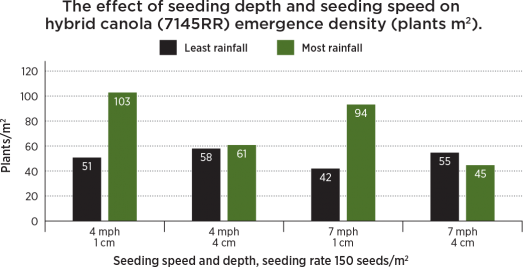Seed at 1/2″ to 1″ deep
Key practice: Optimum seeding depth is ½” to 1″ below the press wheel furrow. This reduces days to emergence and improves plant population and uniformity, which produce season-long benefits.
Key research: Harker, K. Neil, Agriculture and Agri-Food Canada (AAFC). “Seeding Depth and Seeding Speed Effects on No-Till Canola Emergence, Maturity, Yield and Seed Quality.” Canola Journal of Plant Science (2012).
Harker, K. Neil , AAFC. “Factors Influencing Canola Emergence.” Canola Digest Science Edition (2013).
Canola growers who consistently seed at a shallow depth of 1.2 to 2.5 cm (½” to 1″) can reap significant benefits. These include improved plant density, superior competition with weeds, decreased days to emergence, increased canola ground cover, decreased days to flowering and maturity, decreased green seed levels and higher yields.
Shallow seeding of canola into a firm, moist, warm seedbed helps ensure rapid, uniform germination with a high percentage of emergence. Deeply sown seeds require several days longer to emerge and have reduced survival rates due to the insufficient stored energy in canola required to push cotyledons to the surface.
Canola seed is a substantial input cost and poor crop establishment is a continuing concern for growers. Estimates suggest that, on average, only 50 percent of planted seeds emerge — even for seed with a very high germination analysis.
Neil Harker with Agriculture and Agri-Food Canada (AAFC) in Lacombe, AB led a three-year project titled: “Factors Influencing Canola Emergence.” Direct-seeding experiments were conducted at four sites in Western Canada from 2008 to 2011 with data collected from 10 site years. Hybrid or open-pollinated gylphosate-resistant canola was seeded at speeds of four or seven miles per hour and at depths of 1 cm (approximately 1/2″) or 4 cm (approximately 1.5″), in replicated trials.
The researchers found that emergence was greater for canola seeded at a depth of 1 cm compared to 4 cm, with soil moisture being a key influence on results. Canola emergence averaged 35 percent for both seeding depths when precipita-tion levels were low. With ample moisture, the differences became more significant, with an average emergence level of 66 percent when seeding depth was 1 cm.

Canola seeded at 1 cm also performed better across nearly all measured variables in comparison to canola seeded at 4 cm. Harker concluded that, although taking a “recipe” approach to seeding depth is not appropriate for all conditions, “…in most Canadian Prairie production areas, seeding at a depth of 1 cm will not only improve canola emergence density, but will also decrease days to emergence, increase canola ground cover, decrease days to flowering and days to maturity and tend to decrease green seed levels.”
Machinery considerations
Openers that leave a trench or furrow are prone to filling in with soil after rain, which increases the true seeding depth. Opener wear, soil type, moisture and ground speed will influence opener performance. Therefore, seeding depth should be measured carefully during the first few passes in each field and again randomly throughout, or when conditions change.
Seeding speed also influenced canola variables in Harker’s study. Slowing down while seeding allows for accurate seed placement and consistent seeding depth, resulting in more uniform emergence. Ideal speed varies by the type of drill, soil type and moisture, as well as amount and type of crop residue, so it is important to find the speed that is right for both the equipment and conditions.




